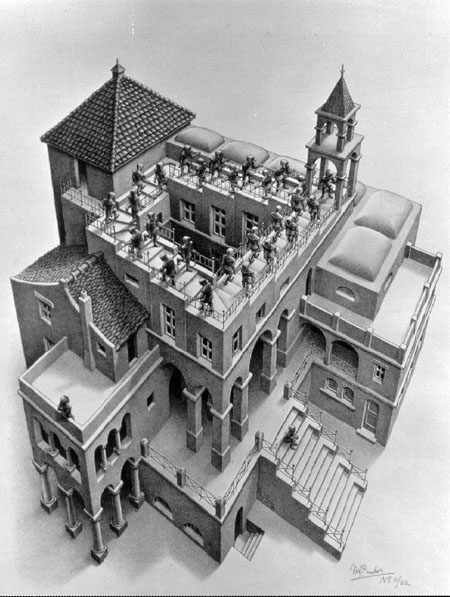Add Infinitum
M.C. Escher and the enduring influence of Roger Penrose
M.C. Escher and the enduring influence of Roger Penrose

The physicist and mathematician Roger Penrose appears to be inescapable. Last summer he was name-checked in Christopher Nolan’s film Inception (2010), in which an ingenious chase scene took place on a set of Penrose stairs – an impossible staircase that uses distorted perspective to give the illusion of eternal ascent (or descent). In a scene of metaphysical slapstick one character is relentlessly pursued up these steps by another, only to find himself eventually chasing his own pursuer.
More recently Penrose’s book, Cycles of Time: An Extraordinary New View of the Universe (published in the UK in 2010 and this year in the US), has introduced a similarly never-ending thesis: that our universe is not the first to have existed. Penrose suggests that traces of past universes can be discerned within our own. These traces take the forms of giant rings (naturally) that are imprinted on the universe’s background radiation. Penrose sees the Big Bang as marking not only the birth of our own universe but the end of a preceding one. ‘Our universe,’ he writes, ‘is what I call an aeon in an endless sequence of aeons.’
Penrose’s fascination with endless sequences and infinite loops stems from 1954 when, as a 23-year-old student of algebraic geometry, he attended the International Congress of Mathematicians in Amsterdam. Amidst lectures on Tauberian theorems and Cesàro summability, several ‘entertainments’ were planned for the visiting delegates. One of these was an exhibition at the Stedelijk Museum by a little-known, middle-aged Dutch artist. The exhibition catalogue described the work as displaying ‘the same playfulness which constantly appears in mathematics in general and which, to a great many mathematicians is the peculiar charm of their subject.’ The artist’s name was Maurits Cornelius Escher. Penrose was captivated.
As a student Escher had not been a promising artist. ‘He is too tight,’ wrote his teacher, ‘too literary-philosophical, a young man too lacking in caprice, too little an artist.’ In the 1920s Escher moved to Italy where he concentrated on self-portraits and the Italian countryside. His use of unconventional perspectives and uncanny reflections hinted at what was to come. So too did his obsessive detailing of cobbled stones and roof tiles. Following a visit to the Alhambra in Granada, Escher became fascinated by the geometric tessellations on its walls. Along with his continued exploration of conceptual ambiguities and perspectival impossibilities he began to study the work of the mathematician George Polya, who had proven that there were only 17 possible ways that a tessellating pattern could be used to tile a flat surface.
At the exhibition Penrose marvelled at Relativity (1953), an image that features three convoluted stairways upon which faceless figures walk, each according to a different centre of gravity. The result is like a hallucinatory Piranesi. Penrose returned to England intent on creating geometrical peculiarities of his own. The result, after some months of study, was the tri-bar or Penrose triangle which looks like a three-dimensional object but which could never exist within three dimensions. It was, wrote Penrose, ‘impossibility in its purest form’.
When Penrose showed the triangle to his father, the brilliant geneticist Lionel Penrose, he gained a firm ally. The older Penrose was renowned for constructing elaborate puzzles and self-replicating machines and began to create similar figures of his own, most notably the Penrose stairs. In 1958, uncertain as to exactly what their findings meant, or where they should publish them, they released a joint paper in the British Journal of Psychology entitled ‘Impossible Objects’.
When Escher got hold of the paper he was as enraptured as Penrose had been at his exhibition. He immediately began to incorporate the shapes into his prints. In Ascending and Descending (1960) a line of cowled figures endlessly climbs a set of Italianate Penrose stairs. In Waterfall (1961), the Penrose triangle is redrawn as an impossible aqueduct that appears to flow uphill. The impossible object was thus the product of a closed loop of stimulation between Escher and the Penroses.
This was to continue. While Roger Penrose had been working on impossible objects, Escher had himself been attempting to represent infinity on a two-dimensional plane. His ‘Circle Limit’ series (1958–60) is a collection of astonishing woodcuts depicting hyperbolic space using tessellating fish, angels and bats. These in turn piqued Penrose’s own tessellating interests, most notably the creation of Penrose tiles, a remarkably asymmetrical and non-repeating type of tessellation. Escher’s last tessellation print was a solution to a puzzle sent to him by Penrose. He entitled it Penrose “Ghosts” (1971).
There has, perhaps, been no more fruitful collaboration between scientist and artist than the one between Escher and Roger Penrose. Certainly none have depicted quite so well the shared ‘playfulness’ between the disciplines. Curiously though, shortly after Penrose’s paper on impossible objects was published, it was revealed that he and Escher were not the first to walk this route. In the 1930s, the Swedish artist Oscar Reutersvard had drawn both an impossible triangle and an impossible staircase. Then there was the impossible cube devised by the 19th-century Swiss crystallographer Louis Necker. The impossible object’s inception seemed to stretch back indefinitely. Somehow this had all happened before. Somehow this seemed very fitting.














